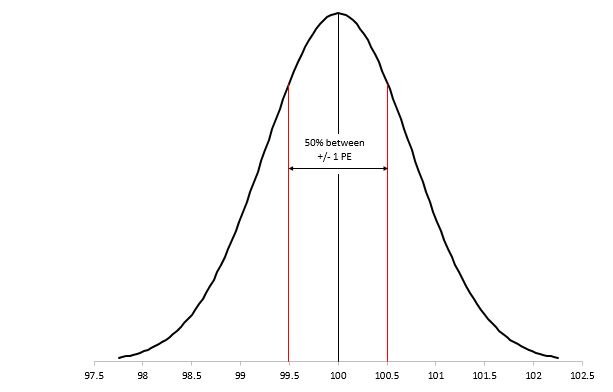Probable Error is basically the correlation coefficient that is fully responsible for the value of the coefficients and its accuracy.

As mentioned, probable error is the coefficient of correlation that supports in finding out about the accurate values of the coefficients. It also helps in determining the reliability of the coefficient.
The calculation of the correlation coefficient usually takes place from the samples. These samples are in pairs. The pairs generally come from a very large population. It is quite an easy job to find out about the limits and bounds of the correlation coefficient.
The correlation coefficient for a population is usually based on the knowledge and the sample relating to the correlation coefficient. Therefore, probable error is the easy way to find out or obtain the correlation coefficient of any population. Hence, the definition is:
Probable Error = 0.674 ×
Here, r = correlation coefficient of ‘n’ pairs of observations for any random sample and N = Total number of observations.
About the Values
- There is hardly any correlation between the different variables if the value of ‘r’ turns out to be less than the value of the probable error
- The value of correlation coefficient is generally certain if and only if the value of ‘r’ is around 6 times more than the value of the error.
- The value of the probable error is in the bounds -1 and +1(-1≤r≤1). So, we can express it in the following manner.
Probable Limit
To get the upper limit and the lower limit, all we need to do is respectively add and subtract the value of probable error from the value of ‘r.’ This is exactly where the value of correlation of coefficient lies.
ρ (rho) = r ± P.E.
Here, the value of rho is nothing but the correlation coefficient of a population. This is also the limit of the correlation of coefficient. Alongside,
Probable Error = 2/3 SE
Here, S.E is Standard Error of Correlation Coefficient
Standard Error = (1-r2)/√N
Standard Error is basically the standard deviation of any mean. It is the sampling distribution of the standard deviation. The standard error is generally used to refer to any sort of estimate belonging to the standard deviation. Therefore, we use probable error to calculate and check the reliability associated with the coefficient.
Advantages of Standard Error
- It helps in finding and reducing the sample errors as well as the measurement errors.
- The standard error of any mean tells about the accuracy of the estimate clearly enough.
Formulas for Calculating Probable Error
Generally, there are three formulas using which we can calculate the probable error. The very first formula is the most common formula to calculate P.E. We use the Pearson product-moment method for calculating the same. It is:
P.E r product-moment = 0.6745(1-r2)/√N
The second formula is applicable when we need the probable error for rho. We use the Spearman method to calculate the value. The formula for the same is:
P.E. ρ = 0.6745(1-ρ2)/√N {1 + 1.086ρ2 + 0.13ρ4 + .002ρ6}
The third formula is applicable to the Pearson coefficient ‘r.’ We calculate it through ρ by using the transmutation formula. The value is r = 2 sin (πρ/6). The formula is given by:
- E rfound from ρ = 0.7063 (1 – r2)√N {1 + 1.042r2 + 0.008r4 + .002r6}
Note: The formula that we are using to calculate probable error is valid and applicable if the given population is normal.
Conditions to find Probable Error
We can find the probable error if and only if the given below conditions are taken care of.
- The data that we have must be a bell-shaped curve. This means that the data has to give us a normal frequency curve
- It is important to take the probable error for measuring the statistics from the sample only
- It is compulsory that the sample items are taken off in an unbiased manner and must remain independent of each other’s value
One thought on “Probable error”